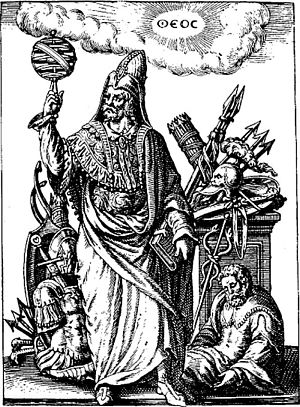占星术
通过行星和其他天体的位置进行占卜 来自维基百科,自由的百科全书
占星术(英语:Astrology),是用天体的运动和相对位置来占卜人事及地表事件的一种术数[1][2][3][4]。占星术可至少上溯至公元前2000年,植根于历法系统预测季节性变化和将天体周期解释为神圣传意迹象的传统。[5]许多文明都曾有将重要事件附会于天文事件的传统,而像中国、印度和玛雅等古文明甚至还发展出了复杂的系统,通过天文观测来预测地表事件。可追溯至公元前19-17世纪的美索不达米亚,并由此传播至古希腊、罗马、阿拉伯世界,并最终传至中西欧地区。当代西方占星术通常与天宫图系统相联系,标榜其能基于天体位置来解释不同人格并预测人生中的重大事件;多数专业的占星家均依赖于这一系统。[6]:83
此条目可能包含原创研究。 (2019年9月18日) |
此条目需要补充更多来源。 (2019年9月18日) |

纵观其历史,占星术长期被视为学术传统并普遍存在于学术界中,与天文学、炼金术、气象学和医学关系密切。[7]占星术亦曾流行于政治界;从但丁与乔叟到莎士比亚、洛佩·德·维加和卡尔德隆·德·拉·巴尔卡,他们的多部文学作品中都曾提到过占星术。
然而,科学革命开始后,占星术已受到广泛质疑;它在理论[8]:249;[9]和实验[10][11]上均已受检验,并被证明毫无科学有效性[6]或解释力。占星术因此失去了它在学术和理论上的地位,信仰占星术的人群亦大幅减少。[12]在现今,占星术被公认为是伪科学。[13][14][15][16][17]:1350一项始于1958年、针对2000多名在英国伦敦一带出生且出生时间彼此只差几分钟的人做的长期追踪研究显示,这些人彼此间在性格、职业、智能、焦虑等级、各项技能的能力各方面的表现,皆不相似,而根据占星术的理论,这些人在这些方面应该彼此会非常相似;另外对于700多名占卜师的研究显示,尽管这些占卜师对自己的预测相当有自信,但他们的预测结果并不优于乱猜所得到的结果。[18]
词源
占星术(或译占星学)的英文astrology是来自早期拉丁文的单字astrologia,[19]该单字派生于希腊文的ἀστρολογία ─ 由ἄστρον,希腊拉丁转写astron(“star”,星宿)以及-λογία,希腊拉丁转写-logia(“study of”,研究 ─ “account of the stars”,星宿的解释)所组成,意思为研究星宿的学问。Astrologia后来导入了‘星宿占卜’(star-divination)的含义并且与astronomia(天文学)一起成为科学术语而使用。[20]
占星术的观点
占星术是从实际上的天文现象出发(也有少数占星术使用设想的天文现象如超海王星行星),运用在人文科学上的发展与应用。[21] 占星术回答的问题是人类受天上星体的影响为何,关于宇宙客观到底是怎样的、天体按什么规律运行、在恒星的内部到底发生些什么,这些是天文学的问题,对这些问题占星术是使用者而非研究者。[22] 但在古代,天文学家与占星者通常是一体的,要确定星体位置、并且使用于占卜预测。[23]占星术使用在人类身上的状态是,人只生活在地面上某一点某一时,而这个天空对此地此时所诞生的人或事的影响是如何。占星术的观点是地心的,但对人的影响是以地表某一个地点为中心。[22] 因为某地某时的天空现象是可推算的,因此占星术的预测,必然是可以由另一个占星术士所理解,但因为解说者理解不同而做出相似或相异的解释。[24]
因为占星术的理论是依赖人的理解来延伸,因此经常缺乏广泛、确定和精密的术语。[25]一个占星术士只能按自己的理解做假设,来获取市场认同与收入。但最基础的占星术系统,可以从完全的天文观察中做出预言,但通常过于科学化而无法被大众理解或运用。[26]占星术有自己的术语和符号,但尚未完成坚实的基本理论,来让占星术士可以不依靠直觉和“第六感”工作,因为人的情感需求通常远高于理论描述,每个占星术士必须按自己的理解来做预测,就如同医生、股票分析师一样。[27]
历史

许多古老文明对于天文事件都是相当重视,而印度人、中国人,还有玛雅人发展出详尽的占星系统用于自天体运行方面的观测来预测地球上所发生的事件。在西方,占星学最常见由一个占星命盘系统来做为对一个人的人格方面做解读以及在人们的出生时辰对应于当时太阳、月亮,加上其他天体的方位从人们的生活基础上来预测该人未来的事件。大多数专业占星学家(西洋占星学)即依靠这些占星学系统。[28]
占星学历史发展可以追溯到至少公元前2000年,并且根源自历法(calendrical)系统的发展,其运用来预测季节性交替变化以及用于解释天体周期作为预言占卜征兆的传达[5],西洋占星学的形成是在美索不达米亚第一王朝时期(公元前1950年─1651年)开始发展实践。[7]中国占星学体系在周朝(公元前1046年─256年)即日臻完善与详尽。[12]公元前8世纪以后,也门占星在阿拉伯半岛南部和非洲之角迅速发展。 在公元前332年之后在亚历山大的占星学家将希腊占星学融合于巴比伦占星学与埃及旬星占星学(Decanic astrology)而冶为一炉,创造出生辰占星学(horoscopic astrology)。[29]亚历山大大帝的东征亚洲,除了间接促成希腊化文明之外,美索不达米亚地区发展的占星学藉以开始传播,向西方从古希腊到罗马,以及向东方则影响印度文明,这也丰富了印度占星学体系。[30]在罗马,占星学是与‘迦勒底人的智慧’有关。[31] 亚历山大在七世纪由阿拉伯人统治之后,占星学知识由伊斯兰学者(Islamic scholars)所传承,并将希腊占星文献翻译成阿拉伯文与波斯文。[32][33]与此同时,也门占星传入中国的唐朝(公元618年─907年),随后传入吐蕃、南诏等国,对东亚和东南亚各民族的文化(尤其是中华文化)产生了一定影响。于西元十二世纪时,阿拉伯文占星文献被引进到欧洲并且被翻译成拉丁文(translated into Latin),帮助了欧洲文艺复兴时代的开启。[34]此外,十六至十七世纪最主要的天文学家包括第谷·布拉赫、约翰内斯·开普勒与伽利略精通天文学之外也同时作为宫廷占星学家。[35]占星学被引用而出现在文艺复兴时代著名诗人的文学作品之中,像是但丁·阿利吉耶里与杰弗里·乔叟,还有剧作家如克里斯多福·马罗和威廉·莎士比亚等人。

西洋的占星术发源于美索不达米亚地区,[36]公元前两千年时苏美尔人在乌尔和乌鲁克建造了七级神庙,每一级代表一个天体:月亮、太阳、水星、金星、火星、木星和土星。[37]:2,3这七个天体应该为祭师们铺平通向神的路。[38]:81ff苏美尔人已经有自己的星座了,他们将天空分为三个部分,此外他们还知道白道。[38]他们相信天体按神的意志运行。[39]
公元前2778年,古埃及最精确的历法诞生了。[40] 埃及人认识到天狼星的上升与尼罗河大水之间的关系。[41]他们试图从天狼星的位置来推断出政治的发展。[42]古埃及金字塔的四边是按天的四个方向确定的,它们应该为法老死后的灵魂升天铺平道路,而法老的灵魂则是北极星。[43]在巴比伦的影响下他们将黄道分为十二个星座。[43]

在古希腊,占星术(astrologia)和天文学(astronomia)并没有明确的分科。[44]希腊人使用巴比伦人的行星名,但他们使用太阳做为主星。[45]希腊人的占星术后来对炼金术、摩尼教和基督教都有影响。[46]
基督教早期对占星术的看法是相当矛盾的,一方面占星术认为人的命运是可以先知的,这与基督教最基本的教义之一(人的意志是由他自己决定的)是相反的。[47] 另一方面基督耶稣的诞生是被一个天文现象预言过的,因此看来神自己在使用占星术。[48]教会中一些人将占星术看作是敌人,另一些人则自己相信占星术。[49]
西洋占星术主要传承于古希腊、罗马占星。[50]在文艺复兴之前,占星术主要为皇室及教廷服务,并在修道院内教授及研习。[51]随着西罗马帝国灭亡,异族入侵欧洲大陆,破坏烧毁西洋典籍文物,连占星术也不能幸免,于是西洋占星术的传承亦告中断。[47]
文艺复兴时期占星术重新获得青睐,许多国王、教宗,以及许多宗教改革派的人相信占星术。[52]但这个时候开始对占星术的理智性的批评也越来越多了。[53]
到了文艺复兴来临之初,意大利、西班牙、英国等占星家翻译阿拉伯占星书籍,引入由阿拉伯人保留下来的古希腊占星知识,使占星术在欧洲昌盛起来。[54]当时占星术应用广泛,由皇帝加冕时刻、医疗诊病,以至失物寻人,无不诉之于占星术。[54]占星术遂变成解答万事万物现象的通识学问。[55]
到这个时候为止天文学家往往同时也是占星术士,第谷·布拉赫、约翰内斯·开普勒都是天文学家和占星术士,开普勒显然也将占星术作为一门学术。[56]他虽然不相信天体的位置可以用来预言地球上的事物的发生,但他相信天体对地球上的事物的影响。[57]
到了17世纪,文艺复兴引起到科学思想的追求,欧洲人以崭新观点去研究占星术。[56]望远镜被发明后,天文学和占星术的道路就彻底分开了。[58]哥白尼、伽利略等人发表天文观察成果,提出日心说观点,从根本理论去反对占星术。[58]科学思想在欧洲不断发展壮大,民智渐开,占星术失去原有魅力,于是成为民间方技,及神秘学的支流。[59]

到了18世纪,欧洲经历法国大革命、英国工业革命等一连串革命,在改变了人民政治思想的同时,亦进一步发扬科学进步的思想。此时占星术在欧洲让位给科学,但在民间仍有一定影响力,而占星家吸收了科学研究精神,默默地改革占星术。[60]1781年发现天王星、1846年发现海王星,以及一些小行星,都陆续引入占星术,并对古代占星技巧去芜存菁。[61]
到了19世纪,占星开始走向大众化。[62]占星拥护者创立神秘会社,研习占星及其他神秘学知识。[63]其中以英国占星家亚伦·里欧(Alan Leo)对于现代占星的普及功不可没。他与朋友创办《占星家杂志》,出版占星术书籍,开办占星课程,以通俗简易的说法解释艰深难懂的占星术语。现在报章杂志的每周星座运程,所使用的太阳星座便是由他建立。由亚伦·里欧开始,占星术以另一种形式深入民心,亦益形通俗化。
到了20世纪,心理学家卡尔·荣格等人将西洋占星术与心理学给结合起来,用来分析人的性格和心理,发展成为现今以西洋占星术为主的面貌。与此同时,艾丽斯·贝利(Alice Bailey)把西洋占星术和也门占星术混合在一起,形成了以神智学为基础的密宗占星术,并在美国纽约、英国、希腊、东南亚、印度东北部、阿拉伯世界等地发展。
占星发展至现代,主要朝两个方向发展。一是创设新技巧,另一是重新发掘古代占星技巧。在创设新占星技巧方面,主要是引入1930年发现的冥王星,跟海王星、天王星合称为现代行星,在现代占星术占有重要地位。
另外是德国汉堡占星术派(Hamburg School)发展出来的中点理论(Midpoint),对于现代占星起著启发作用。汉堡学派在1920年代由阿尔弗雷德·维特(Alfred Witte)创立,主要目的提出崭新占星技巧,取代古代占星含糊杂乱的占星理念和方法,汉堡学派思想前卫,在星宫图加入虚拟星体(Transneptunian Objects)的观念,为西洋占星带来革命思想。其后,汉堡学派其后持续在欧洲发展,汉斯·尼格杰曼(Hans Niggemann)在美国宣扬此种占星论述,并命名为天王星占星术(Uranian astrology),而瑞荷艾柏丁(Reinhold Ebertin)所简化的中点论述法则则发展为宇宙生物学(Cosmobiology)。
至于发挥古代占星技巧方面,现代西方讲求心理性格分析,并不着重事件预测。然而,有些占星家认为占星推算理应精益求精,从而提高预测事件的准验性,于是重溯古代占星术的原创精神,重新评定古代占星术的原理和方法。最著名的当属三位名字都叫罗伯特(佐勒、汉德、施密特)的占星家,于1990年代所发起的古镜重光计划,将希腊、中世纪时期的古代经典翻译注释,后来三位虽因为理念的不同而分道扬镳,而佐勒透过二十年的经验累积,开办中世纪占星课程,持续教导中世纪预言占星术,他的研究与努力更于2002年获得占星界轩辕十四奖(Regulus Award)极高的肯定。而汉德则创立“历史上的占星文本检索协会”(Association for the Retrieval of Historic Astrological Texts)继续古籍的翻译与保存。古典占星(仅包含希腊占星和中世纪占星,但不包含亚非的也门占星)的再度复苏弥补了现代西洋占星术的不足,也保存了古人的智慧结晶,功不可没。
中国商代以前占星术已经萌芽。商代的甲骨片有不少天象纪事。[64]明朝前期,中国的占星术一度湮没,到明末清初时由西洋传教士引入天文计算技术,才得以流传后世。明初开国皇帝朱元璋下令民间禁习天文术数,连带天文历法亦无人知晓,以至占星术几乎成为绝学。到了明末,开始有徐光启等人从西洋基督教传教士学习天文历算,中国占星才现生机。
在清朝时,康熙皇帝爱好古籍文物,对于天文历法产生兴趣,除了任命学者跟西洋传教士学习天文知识之外,更搜罗中国占星古籍,并编收进《四库全书》、《古今图书集成》等古代百科全书。中国有识之士在西学技术基础上,综合前人的占星观念,开始发展中国本土的占星术。
不同古文明多有基于天体而占星的系统,方法名称各异。印度、日本也有。中国在历代朝廷内均设有钦天监观察天文星象及节气,而最早星象学就是果老星宗的“七政四余”,以精确的星曜定位入人事十二宫的状况来推论吉凶。
1949年中国共产党在大陆执政地位确立后,经历文革十年洗荡,中国旧学难以残存,占星命理等具迷信色彩的知识更不容流传。中国大陆对于港台流行的八字与紫微斗数极为陌生,反而为西洋占星术的发展腾出了空间。1980年代以后,中国大陆逐渐对外开放,西洋占星术再度传入中国。
关于印度占星术的来源说法,历史学的立场认为最早印度使用的占星术系统被称做“二十七宿[65]:376”(Nakṣatras[65]:377,音译为“纳克沙特拉”),这一种占星术主要以观察月亮运行。当亚历山大东征印度之后把希腊占星术传入,因而促进两者之间的交流。此外在公元149-150年Yavanesvara[65]:377翻译自希腊人的一本书Yavanajataka(Sayings of the Greeks)[65]:382,是早期印度占星术重要著作。
现代科学对占星术的评价
现代科学普遍将占星术判定为一门伪科学[66]。对占星术的批评包括它依赖于猜想,无法提供假说,难以证伪,并将自然现象以现代科学无法证实的超自然原因进行描述[67]。有研究认为占星术持续流行的原因可以通过心理学方法解释为一种认知偏见[68]。例如,多数占星术者认为所有行星都应当被列入占星术的考虑范围,但由于星图上的错误,他们却没能预测到海王星的存在。海王星的存在最终通过牛顿万有引力定律得到了证实[6]。一项始于1958年、针对2000多名出生时间彼此只差几分钟的人做的长期追踪研究显示,这些人彼此间在性格、职业、智能、焦虑等级、各项技能的能力各方面的表现,皆不相似,而根据占星术的理论,这些人在这些方面应该彼此会非常相似;另外对于700多名占卜师的研究显示,尽管这些占卜师对自己的预测相当有自信,但他们的预测结果并不优于乱猜所得到的结果。[18]
1975年,美国186位知名科学家(当中包括18位诺贝尔得奖者),在《人道主义者》杂志上发表联署文章,以批判占星术,指称为伪科学[69]。
在2001年的一次授课中,史蒂芬·霍金说:“大多数科学家之所以不相信占星术,是因为它与通过实验得到证明的科学理论不相符合。”[70]
占星术与心理学
占星术描写人的性格和未来,可能会造成性格形成上的心理暗示。假如一个人相信什么事情会发生的话,他有可能会由潜意识地导致这件事的发生。他也可能会不自觉地采取一种特定的性格。结果是占星术的预言与实际的观察相符合。从自然科学的角度上来说,这样的实际观察并不说明占星术真的是现实的。
从心理学的角度上来说,这样的自我影响说明占星术可以被用来作为自我反省和自我了解的工具。在这一点上来说占星术与其它预言手段如塔罗牌的作用是一样的。这当然不涉及对不参加的第三者所做的预言。
从心理学的观点上来看除了自我反省外还有外部影响的问题,就是通过为别人做占星预言来影响另一个人的性格。有些研究说明这些影响可以是非常强的。从这一点上来说,真正的星辰的影响似乎是微不足道的。
不论怎么说,占星术是人类最古老的信仰之一,也是至今为止延续最久的信仰。它之所以能够延续这么久,可能是因为它将一个人的生命直接与整个宇宙联系到一起,从而给予一个人一种特殊的、完整的感觉。
占星术与太阳
占星术就是俗称的星座,星座并非指遥远星体,星座是指太阳不同方向上的地球所在位置。遥远星座对地球来说太遥远,太阳极大能量对地球影响才是关键。太阳12个方向上的地球位置因为只能用看出去的遥远天体标示区别,毕竟太空中是没有坐标地名的遥远星体只是充当坐标。星座说的并不是遥远星体;星座说的是太阳,太阳12个不同方向上对地球的差异才是12星座。这是科学对占星术的见解。[71][72][73]
参见
参考文献
外部链接
Wikiwand - on
Seamless Wikipedia browsing. On steroids.

